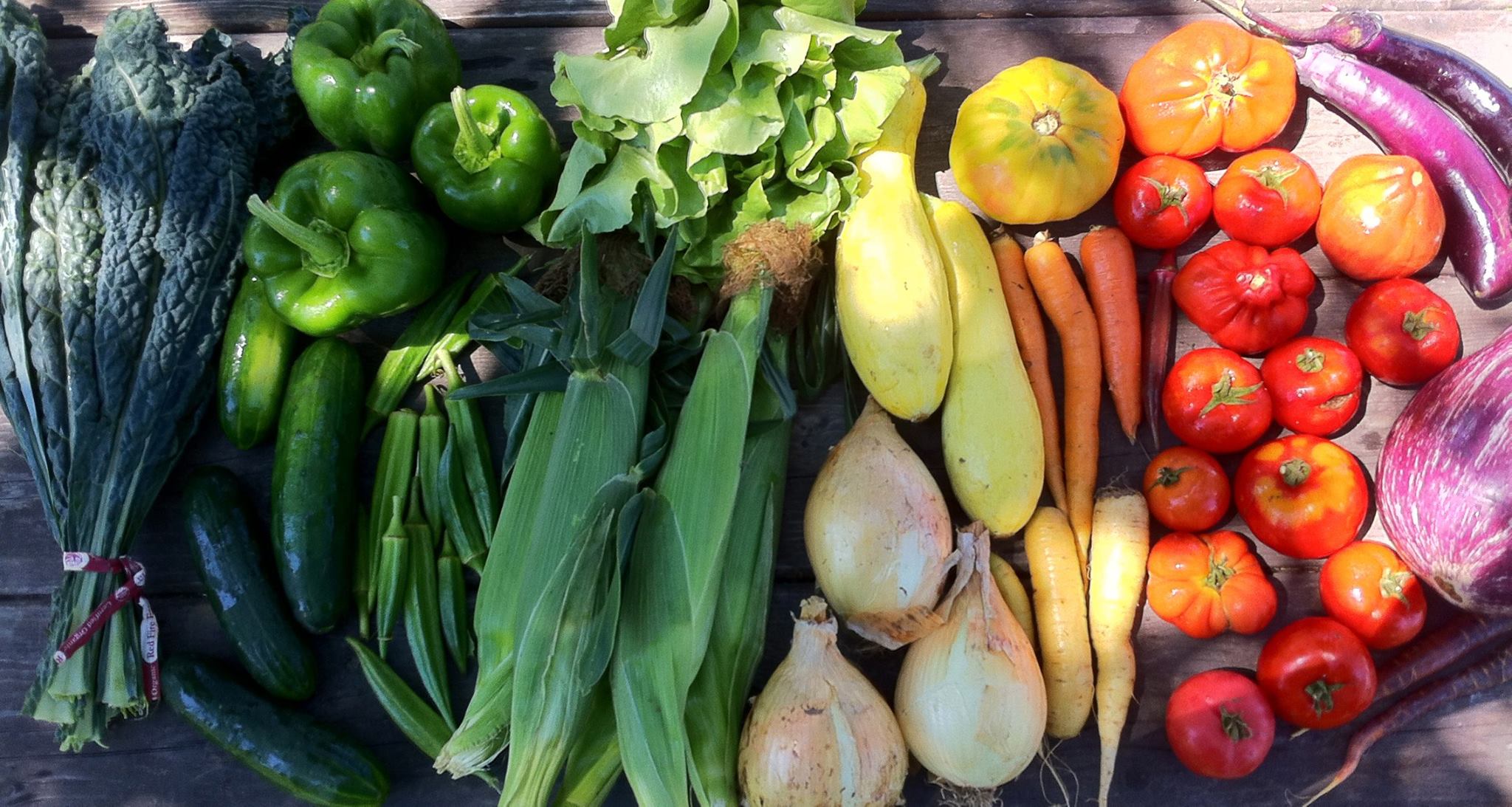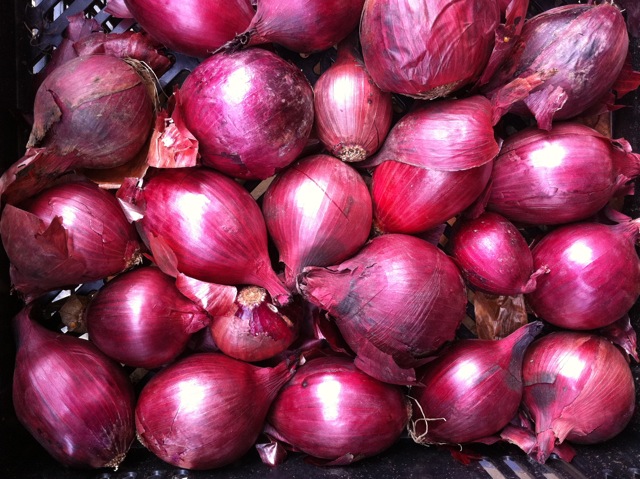8 Ways to Enjoy Fresh Herbs

Garlic, onion, and parsley.. this looks like the start of something delicious! Read on for a green sauce recipe.
Out in the fields and in our gardens we have an amazing local resource of flavor that can elevate snacks and meals to a whole ‘nother level! Culinary herbs are so fun to use and they open up worlds of new combinations of tastes. Come read on and learn eight different ways to enjoy and make use of them.
If you have a CSA farm share with us, we have plenty of herbs in the Pick Your Own Patch that you can harvest for your personal use, fresh cooking and drying or other preserves. We also stock these fresh herbs at our farmers’ markets and produce stands to pick up along with your produce. Get a bunch and use some fresh, then dry the rest for winter!
Beyond the pleasures of cooking, many of the classic culinary herbs also have medicinal uses that you can explore more and incorporate into your cooking for health benefit.
Herbed Butters, Oils & Spreads
Herb butters, also called compound butters, are a deliciously easy way to preserve fresh herbs as well as quickly add flavor to whichever dish you’re making. The basics of herb butter involve combining softened butter with a small handful of finely chopped herbs as well as some salt and pepper. When thoroughly mixed, scoop out onto waxed paper and tie up the ends, or pack the butter into a lidded container. It should last for about a week in the fridge, or several times longer when well-wrapped in the freezer.
Use on hot bread or biscuits, steamed veggies, scrambled eggs, or grilled meats and fish. Virtually any herb can be used to make a compound butter, with popular recipes including rosemary, thyme, basil, parsley, chives or dill.
I still remember the first time I went to an Italian restaurant that served hot bread with an herbed olive oil. Dipping fresh bread into a tasty flavored oil was so fun and just perfect for when you are waiting for a meal. If you can rip the bread, even more fun in my experience. This is very easy to make at home, and works well with both fresh chopped or dried herbs. Combine your desired herbs with about as much oil as you think you will eat up for that meal in a pretty little bowl that makes room to reach your bread in. If you have leftovers you can cook with it later. I use about a quarter cup of oil and a tablespoon of fresh herbs or quite a bit less if dried herbs. One combination I like is basil, garlic, oregano and hot pepper flakes. Sprinkle a little coarse salt in there and mix that in too to help pull out the flavor when you eat it. Make your oil as the first step of making dinner so it has time to infuse. Chopping the herbs small and crushing dried ones a little in your hand before adding will help release the flavors.
A quick herbed spread can be perfect party food with veggies, or a simple dinner when paired with good bread and a hearty green salad. Try this creamy spinach and herb dip shared by CSA member Amy Eichorn. Thank you Amy! She recommends refrigerating overnight so that the flavors can mix, and then serving on toasted, crusty bread.

Green garlic is the young garlic plant. You can use it like a scallion all the way up to the green tops. The white part is most tender raw. Green better for cooking. Use it anywhere you want garlic flavor.
Creamy Spinach and Garlic Spread
8 oz cream cheese softened
Splash milk
1 Tbsp butter
1 green garlic shoot chopped (or 2-3 cloves of garlic)
6 – 8 oz spinach chopped (or Swiss Chard without the ribs)
In sauté pan, place last 3 ingredients and over low heat, soften until garlic is cooked and spinach is wilted. Add all ingredients together and mix well. Chill overnight in the refrigerator to let flavors combine, if you have time.
From CSA member Amy Eichorn, 2015.
Sauces with Herbs
Make sauces ahead of time and keep in the fridge or freezer for ease in cooking later on. If making a stovetop sauce, add herbs a minute or two before serving– delicate herbs like basil and dill are at their most aromatic when just warmed.
I like to listen to podcasts, and I often play the weekly episode from NPR’s Splendid Table while cooking dinner. (As well as America’s Test Kitchen, which is made in Massachusetts!) I heard a few recipe tips for a fresh herb sauces while listening, and they are very adaptable to other herbs too.
Fresh Oregano Sauce from an episode of Splendid Table is wonderful for lamb, eggplant, sliced tomato salad, and more! Pulse these ingredients in a food processor until well mixed and chopped: a bunch worth of oregano leaves, a little bit of capers, a couple cloves garlic, some lemon zest, a good bit of olive oil, and salt to taste.
Green Herb Sauce from the South of France
This is also from that Splendid Table episode, though I have been making a variation on this for a while. Take capers, fresh mint, parsley, oregano, basil, a little garlic, olive oil, almonds (opt), anchovies (opt), and pulse in a food processor until chopped and mixed. Salt and more olive oil, to taste. Add a squeeze of lemon juice right before serving. Use this on roasted potatoes, grilled vegetables, anywhere.
I like to make that sauce in the mortar and pestle with the garlic and salt in there first, then adding the capers, then chopping the herbs up small and putting them in, with olive oil last. Being as I love parsley I often do it with just parsley. I also sometimes put in some chopped onion or shallot, which is especially nice if it sat in some red or white wine vinegar for a few minutes.
Fresh Dill Cream Sauce
That there Splendid Table just tossed out a bunch of fun ideas in a matter of seconds and I have yet to try this one. Chop up your fresh dill fronds, mix with some dijon mustard add a bit of heavy cream to get to a sauce consistency, add a little chopped shallot or onion. This sounds like it would be awesome on anything from the grill.
Try this recipe too for Cilantro Peanut Sauce:

This green herb sauce was made using what’s on hand– we advocate for flexible recipes that use what’s seasonal and available.
1/4 cup peanut butter
1/4 cup honey (or other sweetener)
3 tbs soy sauce
2 tbs cider or rice vinegar (or other light vinegar)
2 tbs lemon or lime juice
2-4 tbs olive oil
1 bunch cilantro, chopped
1 tbs sesame oil (optional)
1-2 cloves garlic, minced (optional) – or green garlic
1 tbs minced fresh ginger (optional, or a little ginger powder)
a little of your favorite spicing agent (cayenne powder, chili flakes)
Mix everything together. You can mix it in a pouring container or the container you’ll store leftovers in later. Add a little water to get desired consistency. Salt to taste.
Also try Scallion-Cilantro Chutney or Roasted Tomatillo Salsa Verde.
Salad Dressings

Winter Savory is an excellent seasoning for beans. Try it in a bean salad with sweet onions and green pepper.
A simple vinaigrette can do wonders to a salad of greens, grains, or pasta. The best part is that just about any herb can find a home in a salad dressing! Whether you’ve got fennel or oregano, there’s a blend of oil and vinegar that will match the flavors of your herbs.
The classic rule of thumb for a vinaigrette is three parts oil to one part acid (lemon juice or vinegar), but this all depends on taste. Adding fresh herbs, shallots, garlic, strawberries, or extra citrus zest will change the balance of your dressing, so be sure to sample often.
Here is a tasty Fresh Dill Dressing: take the fronds from a bunch of dill and puree with 1/2 cup olive oil, 1/4 cup vinegar, 1/4 cup water, 3-4 cloves of garlic, and salt to taste.
Try any of these four seasonal dressings: Herb Vinaigrette, Rosemary Vinaigrette, Strawberry Vinaigrette, or Creamy Roasted Tomato Dressing.
Marinades
Whether for vegetables or meat, a marinade can add subtle flavors to enhance the dish. Acids in the marinade will help break down and tenderize your ingredients, and oil prevents drying out during cooking time as well as gets seasonings to stick.
Try a basic marinade with equal part oil and vinegar, salt and pepper to taste, a few minced cloves of garlic, and a heaping handful of minced rosemary, thyme, and parsley.
For eggplant and summer squash, we love to add soy sauce, olive oil, the spice blend garam masala, garlic, cilantro and parsley to marinades before cooking. Maybe some cayenne pepper flakes for heat.
It’s not quite a marinade, but adding sprigs of rosemary under the skin of chicken before roasting is phenomenal.
Try Lemon Herb Tofu, Grilled Chive Chicken, or Cilantro Lime Marinade.
Pesto
Pestos are probably the first thing that come to mind when thinking about what to do with a fresh bunch of basil, but have you ever tried making pestos with other types of herbs? In addition to mixing up the type of nuts (walnuts, pine nuts, pumpkin seeds, sunflower seeds, pecans, almonds, cashews) or cheese that you might use, different herbs and greens can bring a variety of flavors and colors to your pestos.
For example, using one part minced rosemary to three parts parsley in a pesto will result in a bright green, robust flavor with just the right amount of rosemary. Add parsley to your basil pesto to keep it green, or mix with radish tops for a spicier take on a traditional sweet basil pesto. Even blending hearty greens like kale with a handful of herbs can make a simple smooth pesto.
Classic Basil Pesto:
2 cups fresh basil leaves, packed
1 cup parsley sprigs
1/3 cup freshly grated Parmesan-Reggiano or Romano cheese
1/3 cup extra virgin olive oil
1/3 cup pine nuts or walnuts
3 medium sized garlic cloves, minced
Salt and freshly ground black pepper to taste
Put it all in a food processor and blend until you like the consistency. Sometimes it is nice to stop before everything is completely pureed to get little chunks of texture and flavor.
If you love pesto and like to have it often, you can freeze pesto for the winter. During July and as long as the Basil season lasts we offer basil in bulk orders from the farm.
Pesto is very forgiving and can easily be vegan. I must admit that I never buy pine nuts any more because they are so expensive. I have found that sunflower seeds and cashews make great pesto, and I usually don’t add cheese either. Enough olive oil, garlic and salt make it so good. Sometimes a touch of lemon juice is really good too. It is a great place to use up pretty much any type of green you have from spinach to kale to arugula to garlic chives to mustard greens.
Also try Green Garlic Pesto in season. Not sure what else to do with a fridge overflowing with pesto of all kinds? The Kitchn has tips for creatively using pesto in a variety of dishes.
Teas
Herbal teas can be a great way to warm up on a chilly day, as a natural supplement to your diet, or for medicinal purposes. Drying your own herbs is the best way to save seasonal flavors for later on in the year. A typical ratio for brewing tea is 1 teaspoon of herbs per 6 ounces of water, but this is dependent on the freshness of the herbs and how strong you’d like to brew it.
I am very fond of thyme tea on cooler summer mornings and all fall and winter. For this tea, put a good sprig of thyme (one with 4 or so little branches on it) per mug of tea into water and then boil for a few minutes. The taste is warm and aromatic. You can add honey if you like. Word on the street is that thyme has immune boosting properties and is great to help out right as you start to feel sick. Though I enjoy it at any time.
Cocktails with Herb Simple Syrups and More
Farm to Table drinks can be a fun way to enjoy fresh produce with a variety of delicious combinations. A simple syrup is an effective way to flavor beverages: mix equal parts sugar and water in a saucepan, along with your herb of choice, until the sugar dissolves. If you don’t want want any particulates in the syrup, bundle the herbs with food-safe twine or place herbs in a linen re-usable teabag.
Preserving Herbs
Having access to fresh herbs year-round can be a challenge, and buying bunches of herbs when they’re in season will ensure that you get the highest quality product at peak flavor. Drying or freezing your own herbs is easy and rewarding! For more information, read our blog post on Drying Herbs.
You can save them to enjoy all year-round! Another great way to save herbs is to chop them up, mix with olive oil, pack them in ice cube trays, and freeze. Once frozen take them out of the cube tray and put into freezer storage bags to store in the freezer. Then they are ready to pop into the pan to start flavoring anything when the snow is on the ground.
Do you have any favorite recipes that feature herbs or good ideas for using them? Let us know in the comments or at recipes@redfirefarm.com. Enjoy the season of fresh herbs!









